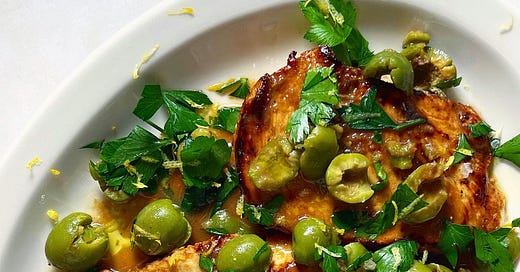Pity the boneless, skinless breast of chicken — nothing to crisp, nothing to spatchcock, no Chef’s Table panache and typically doomed to a Chopt salad. It’s been the foolproof way to add $7.50 to a stale bed of arugula for decades now. Even the boneless, skinless thigh has surfed the Fried Chicken Sandwich wave to new heights; there’s no such renaissance for its white meat counterpart. (Though surely TikTok’s chicken caesar wrap obsession is putting in work for the BSB).
But boneless, skinless chicken breasts have their advantages. For one, they’re cheap, and they’re universally available; try sourcing a top-quality, free range bird that’ll be ready for dinner in 45 minutes and costs five dollars. (Of course, the latter is superior in both taste and ethics, so I’d save the BSB for short notice.) They’ll also quickly soak up whatever marinade you throw at them, so long as you slice them into thin cutlets.
For this recipe, that marinade is similarly simple and dirt cheap. In fact, you likely have it squatting somewhere in the back of your fridge: a jar of pickles, peppers, or olives, the marquee contents long gone but the delicious brine still remaining. That leftover pickle juice is an excellent way to tenderize meat and concentrate its flavor; just as a dry brine works by pulling salt into the chicken’s flesh and juice-ifying its interior, a wet brine does the same. Yes, a wet brine may interfere with a roast chicken’s crispy skin, but no such issue occurs when you’re searing a skinless breast in butter at high heat. Plus, there’s two added bonuses: you don’t need to fiddle around with proportions to make the brine — all the salt, sugar, and vinegar are built right in — and you can simply slap the chicken in a container or plastic bag, fill it up, and seal it. After a couple hours, the chicken will be vastly more flavorful and tender than when you bought it (and no, there won’t be an overwhelming pickle taste after cooking, so long as you don’t use something like gherkin brine).
As easygoing as this recipe is, I still recommend choosing your brine wisely. I used a combination of pickled banana pepper juice and brine from a jar of Partanna castelvetrano olives, which worked fantastically; I’d definitely spring for the banana peppers if you have them. There’s also an additional component to this dish that is no less important: the olive-and-anchovy butter sauce that dresses the seared chicken. For this, you’ll mash together anchovies, garlic, butter, and Worcestershire sauce, then reduce it down in the pan juices with a dry white wine and toss in some torn olives. Sprinkle on some chopped parsley and you have a very elegant weeknight dinner.
Keep reading with a 7-day free trial
Subscribe to Anchovy Trove to keep reading this post and get 7 days of free access to the full post archives.



